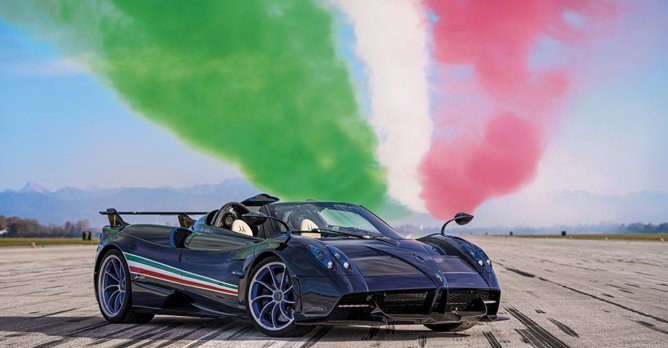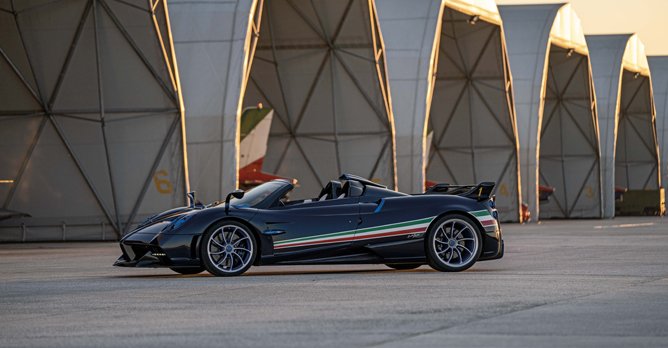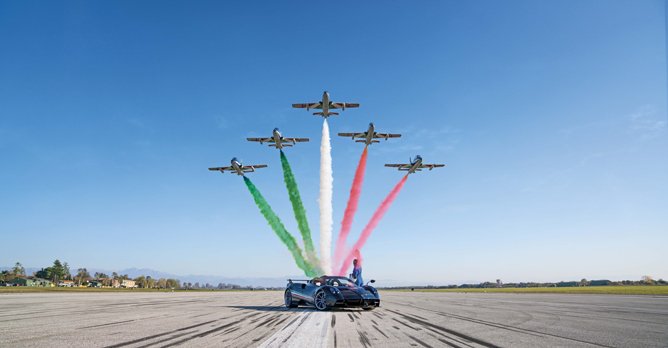The Pagani Huayra Tricolore, a tribute to the Italy's Frecce Tricolori
01 Jan 2021|1,473 views
Pagani Automobili has presented the Huayra Tricolore n celebration of the 60th anniversary of the Italian Air Force Aerobatic Team, the Frecce Tricolori, of which only three examples will be built. With their Aermacchi MB-339A P.A.N. jets, the Frecce Tricolori are one of the most famous aerobatic patrols in the world.
In 2010, Pagani paid tribute to 50 years of such excellence by presenting the Zonda Tricolore, of which only three examples were made. In 2020, the Frecce Tricolori reach their 60th anniversary and Pagani is about to celebrate this new milestone by adding another piece to a mosaic created from passion, tradition and the spirit of collaboration.

A more pronounced front splitter with a completely new aerodynamic profile has been designed for maximum downforce, while the new front bumper with side extractors maximises the efficiency of the intercooler and ensures adequate heat exchange for the powerful Pagani V12, necessary to achieve maximum performance.
Intake efficiency is also guaranteed by the new airscoop, equipped with an innovative air conveying system that allows for an even greater flow of cold air directly to the engine. A new, further optimised rear diffuser has been designed to maximise the extraction of air from the underbody.
Meanwhile, the new wing, fully integrated with the rear hood with which it forms a single carbon fibre component, allows perfect aerodynamic balance, compensating for the increase in downforce at the front.

But the most direct and evident stylistic reference to this symbol of national excellence is provided above all by the external livery, where the tricolour, like an impetuous engulfing flow of air, runs along the side of the car, extending up to the rear light clusters, and matches with the characteristic translucent blue carbon colour.
From the design of the rims, inspired by the propeller of a turbine, to the anodised aluminium frames of the side air intakes and front head lights, typically inspired by aeronautics and machined from billet, the tribute to the Frecce Tricolori is reproduced in every detail of the Huayra Tricolore.
The Huayra Tricolore represents a concentration of specifically aeronautical concepts and technologies developed for a car. The geometry of the suspension assembly is designed to effectively transfer all the engine's power to the ground, reducing dive and roll effects, during braking and cornering respectively.

The Huayra Tricolore is powered by the new Pagani V12, a twin-turbo engine specially developed by Mercedes-AMG, capable of delivering 829bhp and 1,100Nm of torque. All the power and exceptional responsiveness of the engine are transferred to the ground by the seven-speed sequential gearbox with an electromechanical differential.
The entire transmission system is 35% lighter than a dual-clutch gearbox, while the transverse structure not only provides significant overall weight savings, but also helps to drastically reduce the effect of polar inertia, limiting the typical tendency to oversteer that normally affects mid-engined cars.
The flywheel-clutch unit, consisting of an ultra-light triple disc clutch, an electronically controlled differential and a racing-derived tripoid coupling system, reduces potential friction losses from the gearbox to the rear wheels. The entire system ensures a significant increase in responsiveness in high-performance gear changes.

The gear knob, carved from a single block of aluminium and carbon, is then milled through a five-axis numerical control centre and finally hand polished with the special transparent treatment.
Packed with celebratory details, the seats, with the exclusive two-tone colouring in white and blue and the leather inserts with white, red and green stripes, are a direct tribute to the patrol aircraft, with the unmistakable emblem of the Frecce Tricolori chiselled on the four-point seat belt fastener or finely embroidered on the headrests.
The undisputed star of this symphony of aesthetic and technical details that is the Huayra Tricolore's cockpit, is the anemometer of the central console that, through the outer Pitot tube on the front hood, detects the air speed and informs the occupants by means of a dedicated indicator.

Number 0 - Commander, he is the eleventh member of the patrol and directs the display from the ground, as well as all the stages of mission planning and training.
Number 1 - Head of Formation, he leads the patrol during all aerobatic manoeuvres, and his commands decide the pace of the flight.
Number 10 - Soloist, he splits off from the group in the most spectacular sequences. His job is to show the high performance of the aircraft in flight, respecting the entry times between the figures of the formation.
Pagani Automobili has presented the Huayra Tricolore n celebration of the 60th anniversary of the Italian Air Force Aerobatic Team, the Frecce Tricolori, of which only three examples will be built. With their Aermacchi MB-339A P.A.N. jets, the Frecce Tricolori are one of the most famous aerobatic patrols in the world.
In 2010, Pagani paid tribute to 50 years of such excellence by presenting the Zonda Tricolore, of which only three examples were made. In 2020, the Frecce Tricolori reach their 60th anniversary and Pagani is about to celebrate this new milestone by adding another piece to a mosaic created from passion, tradition and the spirit of collaboration.

A more pronounced front splitter with a completely new aerodynamic profile has been designed for maximum downforce, while the new front bumper with side extractors maximises the efficiency of the intercooler and ensures adequate heat exchange for the powerful Pagani V12, necessary to achieve maximum performance.
Intake efficiency is also guaranteed by the new airscoop, equipped with an innovative air conveying system that allows for an even greater flow of cold air directly to the engine. A new, further optimised rear diffuser has been designed to maximise the extraction of air from the underbody.
Meanwhile, the new wing, fully integrated with the rear hood with which it forms a single carbon fibre component, allows perfect aerodynamic balance, compensating for the increase in downforce at the front.

But the most direct and evident stylistic reference to this symbol of national excellence is provided above all by the external livery, where the tricolour, like an impetuous engulfing flow of air, runs along the side of the car, extending up to the rear light clusters, and matches with the characteristic translucent blue carbon colour.
From the design of the rims, inspired by the propeller of a turbine, to the anodised aluminium frames of the side air intakes and front head lights, typically inspired by aeronautics and machined from billet, the tribute to the Frecce Tricolori is reproduced in every detail of the Huayra Tricolore.
The Huayra Tricolore represents a concentration of specifically aeronautical concepts and technologies developed for a car. The geometry of the suspension assembly is designed to effectively transfer all the engine's power to the ground, reducing dive and roll effects, during braking and cornering respectively.

The Huayra Tricolore is powered by the new Pagani V12, a twin-turbo engine specially developed by Mercedes-AMG, capable of delivering 829bhp and 1,100Nm of torque. All the power and exceptional responsiveness of the engine are transferred to the ground by the seven-speed sequential gearbox with an electromechanical differential.
The entire transmission system is 35% lighter than a dual-clutch gearbox, while the transverse structure not only provides significant overall weight savings, but also helps to drastically reduce the effect of polar inertia, limiting the typical tendency to oversteer that normally affects mid-engined cars.
The flywheel-clutch unit, consisting of an ultra-light triple disc clutch, an electronically controlled differential and a racing-derived tripoid coupling system, reduces potential friction losses from the gearbox to the rear wheels. The entire system ensures a significant increase in responsiveness in high-performance gear changes.

The gear knob, carved from a single block of aluminium and carbon, is then milled through a five-axis numerical control centre and finally hand polished with the special transparent treatment.
Packed with celebratory details, the seats, with the exclusive two-tone colouring in white and blue and the leather inserts with white, red and green stripes, are a direct tribute to the patrol aircraft, with the unmistakable emblem of the Frecce Tricolori chiselled on the four-point seat belt fastener or finely embroidered on the headrests.
The undisputed star of this symphony of aesthetic and technical details that is the Huayra Tricolore's cockpit, is the anemometer of the central console that, through the outer Pitot tube on the front hood, detects the air speed and informs the occupants by means of a dedicated indicator.

Number 0 - Commander, he is the eleventh member of the patrol and directs the display from the ground, as well as all the stages of mission planning and training.
Number 1 - Head of Formation, he leads the patrol during all aerobatic manoeuvres, and his commands decide the pace of the flight.
Number 10 - Soloist, he splits off from the group in the most spectacular sequences. His job is to show the high performance of the aircraft in flight, respecting the entry times between the figures of the formation.
Latest COE Prices
November 2025 | 2nd BIDDING
NEXT TENDER: 03 Dec 2025
CAT A$109,000
CAT B$129,890
CAT C$76,389
CAT E$125,001
View Full Results Thank You For Your Subscription.
























